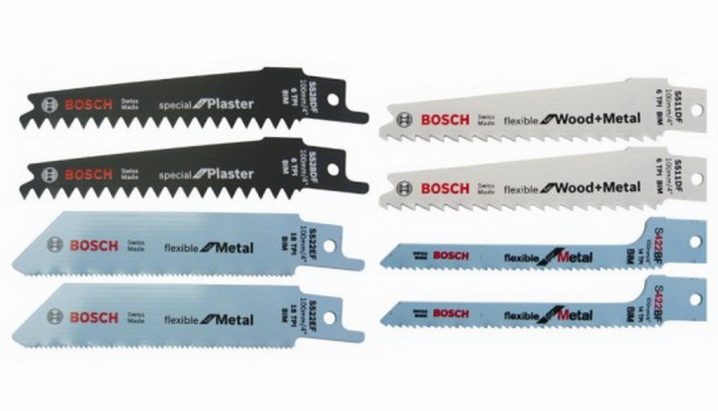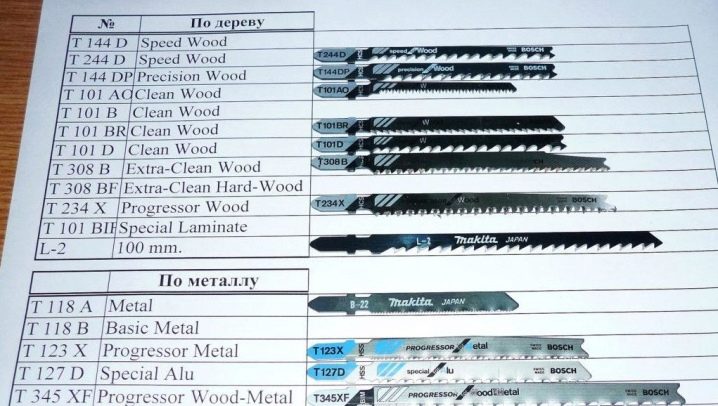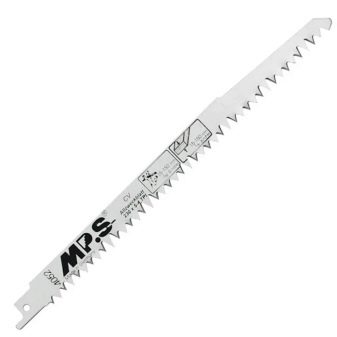Types and characteristics of reciprocating saw blades

Electric shovels are used in construction and finishing works for sawing and making the necessary openings in various materials. The design features of the reciprocating saw allow it to cut down protrusions flush with the wall. These saws are lightweight and easy to use.

Peculiarities
Reciprocating saws are used for cutting materials of various density: chipboard, fiberboard, non-ferrous metals, cast iron, ceramic, concrete, stone surfaces. The blade is a steel file with sharpened teeth located at an angle from the cutting side of the nozzle. The teeth also affect the quality of the material cut. Saws differ in pitch width, degree of sharpening of teeth, their shape, size. Large teeth speed up the cutting of the work surface, but do not guarantee the quality of this procedure. To get a neat cut, blades with a fine set of teeth are used.




Cutting elements are divided into milled and grinding models. The latter type of saws is used for processing soft materials, while milled files interact with hard surfaces: stone, metal, hard wood. The saw shanks are unified, which allows them to be used on various models of reciprocating saws. By the type of movement, the canvases are translational and pendulum. The pendulum view allows you to remove sawdust during operation, protects the blade from overheating. The color of the canvas indicates the use of an alloy of materials.

Options
Each file has a marking on its surface that characterizes the parameters of the working blade. Let's consider these characteristics in more detail.

Shank type
Most of the saws available have a universal shank. Some products are only suitable for branded saws. To make it easier to understand which tool this file is suitable for, letter marking has been created.

Legend:
- T-shaped;
- U-shaped;
- M - Makita firm;
- F - Fein standard.

Canvas
The first number following the shank letter indicates the size of the working blade. The next two or more numbers indicate the specific size of the instance. The size of the canvas is expressed in millimeters:
- 1 - short, up to 75 mm;
- 2 - medium, up to 90 mm;
- 3 - long, up to 150 mm;
- 4 - the longest, more than 150 mm.

The letter after the numerical designation is responsible for the size of the teeth in ascending order. You can consider the letters from A to D. The last letter characterizes the additional parameters of the canvas:
- F - bimetallic working part;
- O - narrow back;
- P - exact cut;
- X - progressive tooth pitch;
- R - reversible teeth.

On the surface of the file, information about the material for which it is intended is indicated, as well as the speed of the blade.
HCS
This abbreviation denotes a blade made of high carbon steel. HCS saws are used for sawing soft materials: fiberboard, chipboard, rubber, plastic, aluminum, sheet or profile metal. Saws for wood differ in the arrangement of the teeth. Most models are available as standard with the same cutting spacing. Variable pitch is used to treat surfaces with foreign objects such as nails. The length of the working part is on average no more than 400 mm.

HSS
The canvas is presented in a curved and curved shape.The design features of the product allow for through cuts in the material. The length of the working file is 300 mm. The main manufacturers of HSS canvases are DeWalt, Metabo.

Bim
BIM canvases are made of bimetallic material. These files have increased strength, flexibility, long service life. They are used when processing materials of various density - from aerated concrete to wood with nails.

HM and CV
HM blade is made of vanadium carbide alloy, CV blade is made of chrome vanadium steel. Both blades are used for cutting porous materials with increased abrasiveness or hard surfaces: fiberglass, ceramics, aerated concrete, tiles, concrete, steel, fiberglass. CV saws are more wear resistant than HCS.


Varieties
Some saws have a wide range of jobs with different materials, but for better cutting, specialized blades should be used.

For aerated concrete
For work on stone, concrete and aerated concrete, blades made of hard alloys marked HM, CV and a reciprocating saw with a power of at least 1 kW are used. The use of a powerful tool is necessary for high-speed and high-quality cutting of material. Metabo accessories have proven to be effective blades for working with abrasive materials.


By wood
Saw blades for woodworking most often come with a reciprocating saw. The blades are made of high-carbon steel with the addition of carbon. The alloy is characterized by increased wear resistance and reliability. These characteristics affect the price of the files. The blades can either be included in the sets of cutting tools, or be sold separately. They are intended for processing soft materials and are marked with the letters HCS. The location of the teeth on the cutting edge is different, and depends on the type of surface to be machined. Most of the models are made with equally spaced teeth.

For metal
HSS saws handle cutting cast iron, aluminum, steel, pipes and other materials. The tip of the saw is equipped with a specially shaped blade that allows for through cuts. The curved shape of the saws ensures high-quality and fast cutting of material along a curve or flush with the wall. Some units have an additional diamond coating, which improves the quality of the cut and increases the life of the saw blade.

A reciprocating saw practically cannot cut a metal product on its own. To facilitate the work, you must first make a through hole on the product and then start cutting. When processing pipes, the surface is cut by the method of completely capturing the diameter of the product with a saw blade. Components with HSS marking are produced by DeWalt, Metabo.
For brick
For work on tiles, bricks, foam blocks and other materials with a similar density, HM blades are used, made of hard alloys with the addition of chromium or carbide.

Broad profile
The universal blade is BIM marked and can handle any material. These saws, made using the combined technology, are durable, strong and flexible. Most of the tools presented in specialized stores are made using this technology.

Selection Tips
To choose a reciprocating saw blade, it is necessary to take into account not only her belonging to work with a certain material, but also pay attention to the following factors.
- Reciprocating saw power. On average, the value fluctuates around 600 W, such saws are hand-held. A hacksaw with a power of 800 W or more is used for gardening and construction work, and is not considered a universal power tool. The power of cordless saws depends on the supply capacity, it also affects the duration of the work performed.
- Sawing system. The pendulum system reduces wear on the working surface and improves productivity. When performing work with increased accuracy, the power tool must be equipped with a vibration frequency regulator.
- Number of strokes per minute. The higher the number, the less time it takes to cut hard materials. The number also indicates the density of the products that the tool can handle. It is advisable to purchase saws with the ability to adjust the stroke.

- Types and type of teeth on the cutting surface. Blades with fine or wavy teeth provide better, cleaner cuts. The types of saw teeth are also selected based on the material being processed. Blades with carbide teeth work better on dense materials: metal, stone, and others.
- Saw shank compatibility with the chuck. In the sets, the saws are mainly presented with a universal shank, they are suitable for electric hacks, hand saws. Specific connectors are labeled with a letter designation and are intended for use with professional equipment.
- Manufacturer. It is recommended to purchase files from trusted brands such as Bosch, DeWalt, Metabo.
- Ease of use. Comfort depends on the type of handle, the presence of an anti-vibration system, a switch for the speed of the saw movement, the possibility of replacing the cutting blades without using special tools, and a battery charge indicator.

Subtleties of use
Before using the tool, it is necessary to adjust the support shoe, while the length of the blade should be minimal. This procedure protects teeth that are not used in the cut from wear. Blind cuts are strictly prohibited! This can damage the gear unit. It is especially worth working with metal pipes, they are most often subject to deformation. It should also be remembered that the use of bent files affects the quality of the work and the performance of the equipment.

To prolong the life of the saw blades, it is recommended to minimize the possibility of the blade hitting various surfaces and objects.
Potential problems and tool repair
When working with a reciprocating saw, problems may periodically arise associated with a broken tool or a jammed blade. What to do if the blade gets stuck or flies out, how to pull it out and sharpen it? Use the following guidelines to correct and identify the problem.

Canvas problems
The reason for the emergence of a flyout or a jam of the file is the wear of the retainer. This problem is found in cheap tools, it rarely appears in professional units. If no problems with the retainer have been identified, it should be remembered that the shank of the blade may not hold in the groove due to a counterfeit consumable. The hole diameter and blade shank do not match the original, which can cause the file to fly out and jam. The solution to this problem is to replace the saw retainer. The jammed blade can be pulled out with pliers after lubricating the saw shank and the retainer with oil. If it is impossible to reach the blade, the tool should be disassembled.

Vibrations during tool operation
The cause may be the appearance of backlash. The bushings that drive the rods are usually made of brass and will wear out over time. Elimination of the malfunction is possible only by replacing parts.

Noise while the tool is running
The reason is bearing wear due to insufficient or lack of lubrication of the parts. The solution is to change the lubricant or parts.

Blade sharpening
When sharpening the working blade, refer to the instructions that come with the tool and files. If it is absent, you should carry out the wiring according to the standard rules.
- The overhang of the cutting edge should not exceed one and a half or two blade thicknesses.
- Exceeding the indicators is permissible only for laying wet wood or cutting material along the grain. When processing such wood with a blade with teeth located at a small distance from each other, the blade gets stuck in the cut.
- Wide spreading of more than 2 thicknesses is not used when processing wood across the grain. When working with such a canvas, you have to apply more effort, the cut turns out to be sloppy, uneven.
- The teeth are sharpened using a file or a file. The canvas should be fixed at an angle of 45 degrees before the procedure. The teeth are machined on each side in turn.
- Checking the quality of sharpening is carried out by the control cut of wood material. If an uneven cut and chipping are detected, the teeth of the blade should be re-sharpened.


For information on how to select and install reciprocating saw blades, see the next video.













The comment was sent successfully.